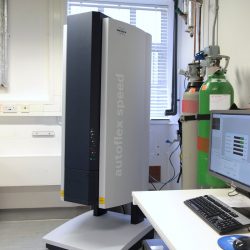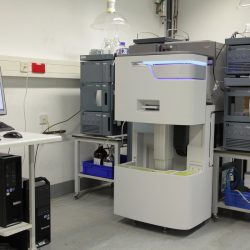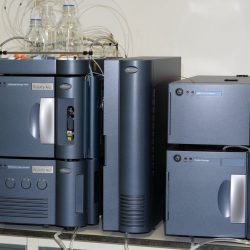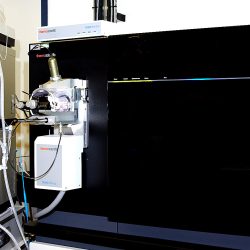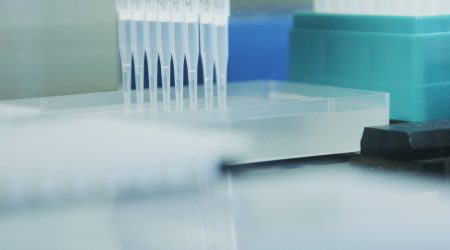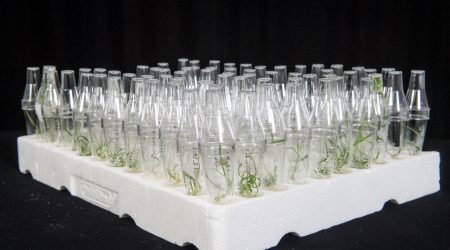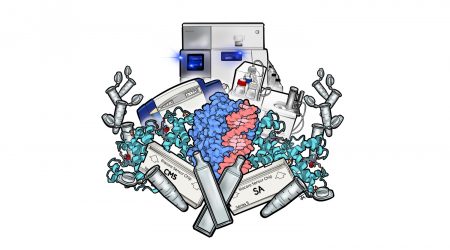Proteomics
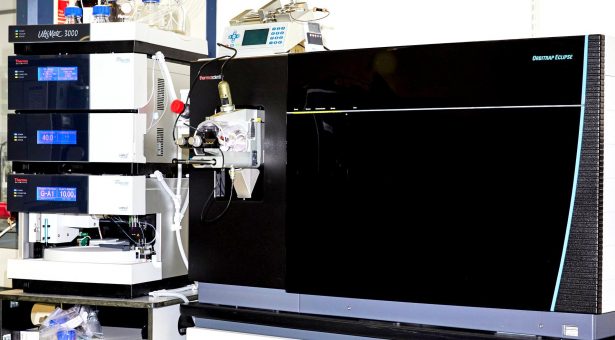
Our Proteomics Facility uses mass spectrometry and is equipped with state-of-the-art mass spectrometers.
This allows for a broad range of methods including analysis of individual proteins (e.g. intact mass, sequencing, identification), the qualitative and quantitative analysis of complex protein samples (e.g. CoIPs, expression studies, modifications, isotope labelling), as well as mass spectrometry imaging and ion mobility.
We offer advice, collaboration, and service across the Norwich Research Park, the wider research community and commercial users.
Some of the methods (especially in quantitative proteomics) are very complex and require substantial effort and input from our side to the setup and adaptation of special projects.
For collaborative projects, we follow internationally established guidelines suggesting that if scientists from the John Innes Centre contributed more than just routine techniques, they should be co-authors of papers that use data generated by the facility.
Contact us for a discussion of your special proteomics project.
Proteomics applications
- Protein and peptide off-line fractionation (HPLC)
- Determination of protein intact mass
- Bottom up protein identification (after trypsin digestion); Gel bands and Complex mixtures: CoIP, over-expression, pull downs, total cell lysates
- Top down protein identification
- Protein mass fingerprinting (PMF) using MALDI-TOF
- Phosphoproteomics; Phosphopeptide enrichment (including non-canonical) and Phosphopeptide identification and quantification
- Study of post translational modifications (PTM)
- Quantification – Cellular protein expression analysis; Label free, Targeted quantification (SRM), Isobaric labelling: iTRAQ or TMT, Stable Isotope Labeling: SILAC
- Mass spectrometry imaging
- Ion mobility for small molecule analysis
- Data analysis
Equipment
Mass Spectrometers
Mass Spectrometers
- Thermo Scientific™ Orbitrap Eclipse™ Tribrid™ mass spectrometer LCMS with Thermo UltiMate® 3000 RSLCnano LC system and with the Thermo FAIMS PRO DUO interphase
- Waters Synapt G2-Si QTOF LC-MS
- Waters Xevo TQS Triple Quad LC-MS
- Bruker Autoflex™ Speed Maldi-TOF/TOF
HPLC
- HPLC: Waters ACQUITY Arc Bio System
Software
The following programmes for proteomics data processing, protein identification by database search, and quantification, are available team to cover the different needs of sample analysis:
- Mascot Server 2.8
- Mascot Distiller 2.8
- Proteome Discoverer™ 3.1 (Thermo) with the new AI-driven search engine CHIMERYS (MSAID)
- Scaffold™ 4.11.0
- Masslynx™ (Waters)
- HDI 1.4 (Waters imaging software)
- FlexAnalysis™ (Bruker)
- FlexImaging™ (Bruker)
- Skyline
- MaxQuant
- MSFragger
- SAINTexpress
Special applications
Analysis of individual proteins
The proteomics team can run a range of analyses of individual proteins, including;
- Intact mass analysis (MALDI-TOF or LCMS-ESI)
- Protein sequencing by MALDI-ISD
- Both termini can be sequenced up to 20-30 aa, but the terminal 10 aa can only be estimated if the sequence is known and success depends on individual protein and purity of sample.
- Identification of individual proteins – can done by peptide mass fingerprinting (PMF) after trypsin digestion on the MALDI-TOF but often LC-MS/MS on an Orbitrap Tribrid™ is needed for reliable identifications
Analysis of complex protein samples
- For protein identification – Done by nanoLC-MS/MS on Orbitrap instruments. The available instruments provide high sensitivity and speed for analysis of complex samples. Samples can be of different origin (cell lysates, tissue extracts, fractions, CoIP’s) and can be in solution or in gel. Very complex samples can be fractionated by IEX or RP HPLC.
- For protein quantitation (protein expression analysis) – For complex relative quantification we use the Tandem Mass Tag (TMT) Systems (Thermo Scientific) which are based on stable isotope labelling. The mass spectrometer with the most advanced methods for TMT based quantification is the new Orbitrap Eclipse™ (Thermo Scientific) which is available in our facility. It features advanced hard- and software for improved TMT analysis including multiple precursor MS3 for the TMT ions as well as real-time search for specific and reliable peptide quantification. For TMT and iTRAQ, chemical labelling will be provided, whereas other labelling methods (like SILAC, 15N) cannot be provided by our facility. Mass spectrometric analysis can be performed for all labelled samples.
- Analysis of post-translational modifications – Modifications can be detected after MS/MS in a database search considering the possible mass differences. Enrichment of modified peptides is necessary for low abundance modifications. Phosphopeptide enrichment is established in our facility. It includes Titanium-based enrichment of standard phosphopeptides (modification of Ser, Thr, Tyr residues) as well as SAX-based enrichment of non-canonical phosphopeptides.
- Ion mobility analysis – Ion mobility is available on the Synapt G2-Si (Waters). Isobaric isomers can be distinguished by their different ion mobility drift time. Collisional cross sections can be determined if suitable calibrants are available.
- MALDI-Imaging – MALDI-imaging of tissues and tissue sections can be performed with the Bruker Autoflex Speed Maldi-TOF/TOF and with the Waters Synapt G2-Si equipped with a MALDI source.
Proteomics publications
- Jiang, Y., Curran-French, S., Koh, S.W.H., Jamil, I., Gu, B., Argirò, L., Lopez, S.G., Martins, C., Saalbach, G., Moubayidin, L. O-glycosylation of the transcription factor SPATULA promotes style development in Arabidopsis. Nat. Plants (2024). https://doi.org/10.1038/s41477-023-01617-4
- Juodeikis, R., Martins, C., Saalbach, G., Richardson, J., Koev, T., Baker, D. J., Defernez, M., Warren, M., & Carding, S. R. (2024). Differential temporal release and lipoprotein loading in B. thetaiotaomicron bacterial extracellular vesicles. Journal of Extracellular Vesicles, 13, e12406. https://doi.org/10.1002/jev2.12406
- Polturak G, Misra RC, El-Demerdash A, Owen C, Steed A, McDonald HP, Wang J, Saalbach G, Martins C, Chartrain L, Wilkinson B, Nicholson P, Osbourn A. Discovery of isoflavone phytoalexins in wheat reveals an alternative route to isoflavonoid biosynthesis. Nat Commun. 2023 Nov 1;14(1):6977. doi: 10.1038/s41467-023-42464-3. PMID: 37914713; PMCID: PMC10620232.
- van Wonderen JH, Crack JC, Edwards MJ, Clarke TA, Saalbach G, Martins C, Butt JN. Liquid-chromatography mass spectrometry describes post-translational modification of Shewanella outer membrane proteins. Biochim Biophys Acta Biomembr. 2023 Sep 4:184221. doi: 10.1016/j.bbamem.2023.184221. Epub ahead of print. PMID: 37673350.
- Kamble NU, Makhamadnojov F, Fahy B, Martins C, Saalbach G, Seung D. Initiation of B-type starch granules in wheat endosperm requires the plastidial α-glucan phosphorylase PHS1. Plant Cell. 2023 Aug 18:koad217. doi: 10.1093/plcell/koad217. Epub ahead of print. PMID: 37595145.
- McLean TC, Beaton ADM, Martins C, Saalbach G, Chandra G, Wilkinson B, Hutchings MI. Evidence of a role for CutRS and actinorhodin in the secretion stress response in Streptomyces coelicolor M145. Microbiology (Reading). 2023 Jul;169(7). doi: 10.1099/mic.0.001358. PMID: 37418299
- Thompson CMA, Hall JPJ , Chandra G, Martins C, Saalbach G, Bird S, Ford S , Little RH, Piazza A, Harrison E , Jackson RW, Brockhurst MA, Malone JG. Plasmid manipulation of bacterial behaviour through translational regulatory crosstalk. PLoS Biol. 2023 Feb 14;21(2):e3001988. doi: 10.1371/journal.pbio.3001988. eCollection 2023 Feb. PMID: 3678729
- Bridge T, Wegmann U, Crack JC, Orman K, Shaikh SA, Farndon W, Martins C, Saalbach G, Sachdeva A. Site-specific encoding of photoactivity and photoreactivity into antibody fragments. Nat Chem Biol. 2023 Feb 16. doi: 10.1038/s41589-022-01251-9. Epub ahead of print. PMID: 36797401.
- Buttress T, He S, Wang L, Zhou S, Saalbach G, Vickers M, Li G, Li P, Feng X. Histone H2B.8 compacts flowering plant sperm through chromatin phase separation. Nature. 2022 Nov; 611(7936):614-622. doi: 10.1038/s41586-022-05386-6. Epub 2022 Nov 2. PMID: 36323776; PMCID: PMC9668745.
- Li, J., Scarano, A., Gonzalez, N.M., D’Orso, F., Yue, Y., Nemeth, K., Saalbach, G., Hill. L., Martins, C., Moran, R., Santino, A., Martin, C. Biofortified tomatoes provide a new route to vitamin D sufficiency. Nat. Plants (2022). https://doi.org/10.1038/s41477-022-01154-6; PMID: 35606499.
- Mikulski P, Wolff P, Lu T, Nielsen M, Echevarria EF, Zhu D, Questa JI, Saalbach G, Martins C, Dean C. VAL1 acts as an assembly platform co-ordinating co-transcriptional repression and chromatin regulation at Arabidopsis FLC. Nat Commun. 2022 Sep 21;13(1):5542. doi: 10.1038/s41467-022-32897-7. PMID: 36130923.
- Appia-Ayme C, Little R, Chandra G, de Oliveira Martins C, Bueno Batista M, Dixon R. Interactions between paralogous bacterial enhancer-binding proteins enable metal-dependent regulation of alternative nitrogenases in Azotobacter vinelandii. Mol Microbiol. 2022 Jul;118(1-2):105-124. doi: 10.1111/mmi.14955. Epub 2022 Jun 29. PMID: 35718936.
- Thimmappa R, Wang S, Zheng M, Misra RC, Huang AC, Saalbach G, Chang Y, Zhou Z, Hinman V, Bao Z, Osbourn A. Biosynthesis of saponin defensive compounds in sea cucumbers. Nat Chem Biol (2022) Jul;18(7):774-781. doi: 10.1038/s41589-022-01054-y. Epub 2022 Jun 27.
- Tomlinson ML, Zhao M, Barclay EJ, Li J, Li H, Felix J, Hill L, Saalbach G, Rejzek M, Yang D, Zhao Q, Kroon P, Wang W, Bao Y, Howes M-JR, Tatsis EC, Martin C. Diterpenoids from Scutellaria barbata induce tumour-selective cytotoxicity by taking the brakes off apoptosis. Medicinal Plant Biology 1:3 (2022) doi: 10.48130/MPB-2022-0003.
- Singh RP, Bhaiyya R, Thakur R, Niharika J, Singh C, Latousakis D, Saalbach G, Nepogodiev SA, Singh P, Sharma SC, Sengupta S, Juge N, Field RA. Biochemical Basis of Xylooligosaccharide Utilisation by Gut Bacteria. Int J Mol Sci. 2022 Mar 10;23(6):2992. doi: 10.3390/ijms23062992. PMID: 35328413; PMCID: PMC8954004.
- Schulte CCM, Borah K, Wheatley RM, Terpolilli JJ, Saalbach G, Crang N, de Groot DH, Ratcliffe RG, Kruger NJ, Papachristodoulou A, Poole PS. Metabolic control of nitrogen fixation in rhizobium-legume symbioses. Science Advances 2021; 7(31):eabh2433.
- Martins CO, Huet S, Yi SS, Ritorto MS, Landgren O, Dogan A, Chapman JR. Mass Spectrometry-Based Method Targeting Ig Variable Regions for Assessment of Minimal Residual Disease in Multiple Myeloma. J Mol Diagn. 2020 Jul;22(7):901-911. doi: 10.1016/j.jmoldx.2020.04.002. Epub 2020 Apr 14. PMID: 32302778; PMCID: PMC7338887.
- Perrotta AR, Borrelli GM, Martins CO, Kallas EG, Sanabani SS, Griffith LG, Alm EJ, Abrao MS. The Vaginal Microbiome as a Tool to Predict rASRM Stage of Disease in Endometriosis: a Pilot Study. Reprod Sci. 2020 Apr;27(4):1064-1073. doi: 10.1007/s43032-019-00113-5. Epub 2020 Jan 6. PMID: 32046455; PMCID: PMC7539818.
- Grenga L, Little RH, Chandra G, Woodcock SD, Saalbach G, Morris RJ, Malone JG. Control of mRNA translation by dynamic ribosome modification. PLoS Genet. 2020;16(6):e1008837. Published 2020 Jun 25.
- Garcia-Gutierrez, E., O’Connor, P.M., Saalbach, G., Walsh, C.J., Hegarty, J.W., Guinane, C.M., Mayer, M.J., Narbad, A., Cotter, P.D. (2020) First evidence of production of the lantibiotic nisin P. Scientific Reports 10, 3738.
- Gomez-Escribano J.P., Castro J.F., Razmilic V., Jarmusch S.A., Saalbach G., Ebel R., Jaspars M., Andrews B., Asenjo J.A., Bibb M.J. (2019) Heterologous Expression of a Cryptic Gene Cluster from Streptomyces leeuwenhoekii C34T Yields a Novel Lasso Peptide, Leepeptin. Appl Environ Microbiol. 85(23), 01752-19
- Figo D, De Amicis K, Neiva Santos de Aquino D, Pomiecinski F, Gadermaier G, Briza P, Eduardo Santos Galvão C, Bussador do Amaral J, de Oliveira Martins C, Fernandes Morato Castro F, Kalil J, Souza Santos K. Cashew Tree Pollen: An Unknown Source of IgE-Reactive Molecules. Int J Mol Sci. 2019 May 15;20(10):2397. doi: 10.3390/ijms20102397. PMID: 31096561; PMCID: PMC6566400.
- Martins CO, Lezcano C, Yi SS, Landau HJ, Chapman JR, Dogan A. Novel iatrogenic amyloidosis caused by peptide drug liraglutide: a clinical mimic of AL amyloidosis. Haematologica 2018;103(12):e610-e612; https://doi.org/10.3324/haematol.2018.203000.
- Gherghisan-Filip C., Saalbach G., Hatziioanou D., Narbad A., Mayer M. J. (2018) Processing and Structure of the Lantibiotic Peptide Nso From the Human Gut Bacterium Blautia obeum A2-162 analysed by Mass Spectrometry. Scientific reports 8 10077
- Kuhaudomlarp S., Patron N. J., Henrissat B., Rejzek M., Saalbach G., Field R. A. (2018) Identification ofEuglena gracilisß-1,3-glucan phosphorylase and establishment of a new glycoside hydrolase (GH) family GH149. Journal of Biological Chemistry 293 2865-2876
- Hems E. S., Wagstaff B. A., Saalbach G., Field R. A. (2018) CuAAC click chemistry for the enhanced detection of novel alkyne-based natural product toxins Chemical Communications 54 12234–12237
- Louveau T., Orme A., Pfalzgraf H., Stephenson M. J., Melton R., Saalbach G., Hemmings A. M., Leveau A., Rejzek M., Vickerstaff R. J., Langdon T., Field R. A., Osbourn A. (2018) Analysis of Two New Arabinosyltransferases Belonging to the Carbohydrate-Active Enzyme (CAZY) Glycosyl Transferase Family1 Provides Insights into Disease Resistance and Sugar Donor Specificity. Plant Cell 30 3038-3057
- Lichman B. R., Kamileen M. O., Titchiner G. R., Saalbach G., Stevenson C. E. M., Lawson D. M., O’Connor S. E. (2018) Uncoupled activation and cyclization in catmint reductive terpenoid biosynthesis. Nature Chemical Biology 15 71-79
- Dong H., Dumenil J., Lu F. H., Na L., Vanhaeren H., Naumann C., Klecker M., Prior R., Smith C., McKenzie N., Saalbach G., Chen L., Xia T., Gonzalez N., Seguela M., Inze D., Dissmeyer N., Li Y., Bevan M. W. (2017) Ubiquitylation activates a peptidase that promotes cleavage and destabilization of its activating E3 ligases and diverse growth regulatory proteins to limit cell proliferation in Arabidopsis. Genes & Development 31 197-208
- Hatziioanou D., Gherghisan-Filip C., Saalbach G., Horn N., Wegmann U., Duncan S. H., Flint H. J., Mayer M. J., Narbad A. (2017) Discovery of a novel lantibiotic nisin O from Blautia obeum A2-162, isolated from the human gastrointestinal tract Microbiology-SGM
- Grenga L., Chandra G., Saalbach G., Galmozzi C. V., Kramer G., Malone J. (2017) Analyzing the Complex Regulatory Landscape of Hfq – an Integrative, Multi-Omics Approach. Frontiers in Microbiology 8 1784
- Ivanova I. M., Nepogodiev S. A., Saalbach G., O’Neill E. C., Urbaniak M. D., Ferguson M. A. J., Gurcha S. S., Besra G. S., Field R. A. (2017) Fluorescent mannosides serve as acceptor substrates for glycosyltransferase and sugar-1-phosphate transferase activities in Euglena gracilis membranes. Carbohydrate Research 438 26-38
- O’Neill E. C., Saalbach G., Field R. A., O’Connor S. E. (2016) Gene Discovery for Synthetic Biology: Exploring the Novel Natural Product Biosynthetic Capacity of Eukaryotic Microalgae. Methods in Enzymology, Vol. 576 Burlington: Academic Press 99-120#
- Little R. H., Grenga L., Saalbach G., Howat A. M., Pfeilmeier S., Trampari E., Malone J. G. (2016) Adaptive remodeling of the bacterial proteome by specific ribosomal modification regulates Pseudomonas infection and niche colonisation PLoS Genetics 12 (2) e1005837
- Andriotis V. M., Saalbach G., Waugh R., Field R. A., Smith A. M. (2016) The Maltase Involved in Starch Metabolism in Barley Endosperm Is Encoded by a Single Gene. PLoS ONE 11 e0151642
- Campo V. L., Ivanova I. M., Carvalho I., Lopes C. D., Carneiro Z. A., Saalbach G., Schenkman S., da Silva J. S., Nepogodiev S. A., Field R. A. (2015) Click chemistry oligomerisation of azido-alkyne-functionalised galactose accesses triazole-linked linear oligomers and macrocycles that inhibit Trypanosoma cruzi macrophage invasion Tetrahedron 71 7344-7353
- Walden M., Edwards J. M., Dziewulska A. M., Bergmann R., Saalbach G., Kan S. Y., Miller O. K., Weckener M., Jackson R. J., Shirran S. L., Botting C. H., Florence G. J., Rohde M., Banfield M. J., Schwarz-Linek U. (2015) An internal thioester in a pathogen surface protein mediates covalent host binding. eLife 4 e06638
- Derbyshire P., Ménard D., Green P., Saalbach G., Buschmann H., Lloyd C. W., Pesquet E. (2015) Proteomic Analysis of Microtubule Interacting Proteins over the Course of Xylem Tracheary Element Formation in Arabidopsis. Plant Cell 27 2709-26
- Jefferson M., Donaszi-Ivanov A., Pollen S., Dalmay T., Saalbach G., Powell P. P. (2014) Host Factors interacting with the Pestivirus N terminal protease, Npro are Components of the Ribonucleoprotein Complex., J Virology 88, 10340-10353
- Rashid A. M., Saalbach G., Bornemann S. (2014) Discrimination of large maltooligosaccharides from isobaric dextran and pullulan using ion mobility mass spectrometry Rapid Comm Mass Spectrometry 28, 191-199.

